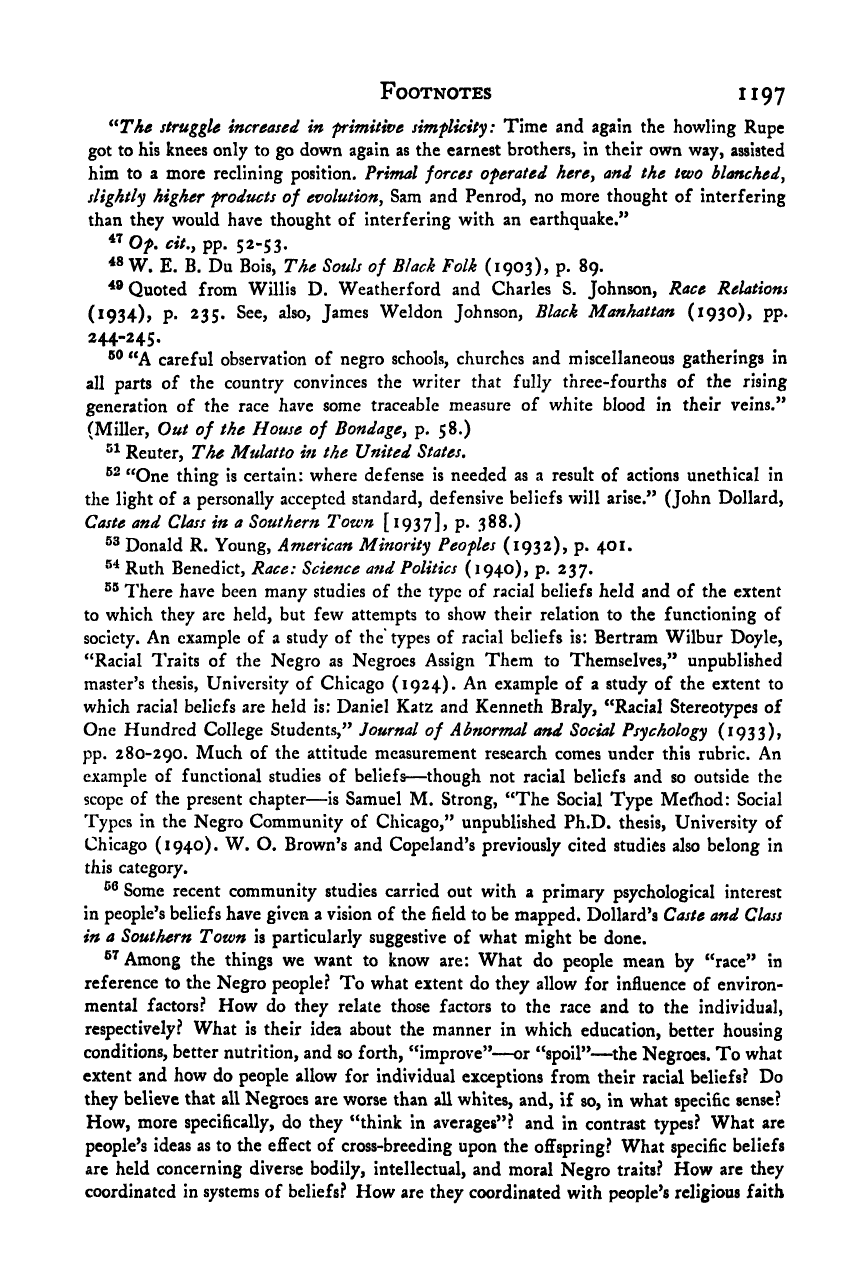Note: Gunnar Myrdal died in 1987, less than 70 years ago. Therefore, this work is protected by copyright, restricting your legal rights to reproduce it. However, you are welcome to view it on screen, as you do now. Read more about copyright.
Full resolution (TIFF) - On this page / på denna sida - Footnotes - Chapter 4

<< prev. page << föreg. sida << >> nästa sida >> next page >>
Below is the raw OCR text
from the above scanned image.
Do you see an error? Proofread the page now!
Här nedan syns maskintolkade texten från faksimilbilden ovan.
Ser du något fel? Korrekturläs sidan nu!
This page has never been proofread. / Denna sida har aldrig korrekturlästs.
Footnotes 1197
struggle increased in frimitive simflicity: Time and again the howling Rupe
got to his knees only to go down again as the earnest brothers, in their own way, assisted
him to a more reclining position. Primal forces operated herey and the two hlanchedy
slightly higher products of evolution
y
Sam and Penrod, no more thought of interfering
than they would have thought of interfering with an earthquake.”
« Of. cit., pp. 52-53.
W. E. B. Du Bois, The Souls of Black Folk (1903), p. 89.
Quoted from Willis D. Weatherford and Charles S. Johnson, Race Relations
(1934), p. 235. See, also, James Weldon Johnson, Black Manhattan (1930), pp.
244-245.
“A careful observation of negro schools, churches and miscellaneous gatherings in
all parts of the country convinces the writer that fully three-fourths of the rising
generation of the race have some traceable measure of white blood in their veins.”
(Miller, Out of the House of Bondage
y
p. 58.)
Reuter, The Mulatto in the United States,
“One thing is certain: where defense is needed as a result of actions unethical in
the light of a personally accepted standard, defensive beliefs will arise.” (John Dollard,
Caste and Class in a Southern Town [1937], p. 388.)
Donald R. Young, American Minority Peoples (1932), p. 40 1.
Ruth Benedict, Race: Science a7id Politics (1940), p. 237.
There have been many studies of the type of racial beliefs held and of the extent
to which they arc held, but few attempts to show their relation to the functioning of
society. An example of a study of the types of racial beliefs is: Bertram Wilbur Doyle,
“Racial Traits of the Negro as Negroes Assign Them to Themselves,” unpublished
master’s thesis, University of Chicago (1924). An example of a study of the extent to
which racial beliefs are held is: Daniel Katz and Kenneth Braly, “Racial Stereotypes of
One Hundred College Students,” Journal of Abnormal and Social Psychology (1933),
pp. 280-290. Much of the attitude measurement research comes under this rubric. An
example of functional studies of beliefs—though not racial beliefs and so outside the
scope of the present chapter—is Samuel M. Strong, “The Social Type Melfhod: Social
Types in the Negro Community of Chicago,” unpublished Ph.D. thesis, University of
Chicago (1940). W. O. Brown’s and Copeland’s previously cited studies also belong in
this category.
Some recent community studies carried out with a primary psychological interest
in people’s beliefs have given a vision of the field to be mapped. Dollard’s Caste and Class
in a Southern Town is particularly suggestive of what might be done.
Among the things we want to know are: What do people mean by “race” in
reference to the Negro people? To what extent do they allow for influence of environ-
mental factors? How do they relate those factors to the race and to the individual,
respectively? What is their idea about the manner in which education, better housing
conditions, better nutrition, and so forth, “improve”—or “spoil”—^the Negroes. To what
extent and how do people allow for individual exceptions from their racial beliefs? Do
they believe that all Negroes are worse than all whites, and, if so, in what specific sense?
How, more specifically, do they “think in averages”? and in contrast types? What are
people’s ideas as to the effect of cross-breeding upon the offspring? What specific beliefs
are held concerning diverse bodily, intellectual, and moral Negro traits? How are they
coordinated in systems of beliefs? How are they coordinated with people’s religious faith
<< prev. page << föreg. sida << >> nästa sida >> next page >>